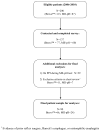Many patients continue using proton pump inhibitors after negative results from tests for reflux disease
- PMID: 22366177
- PMCID: PMC3547497
- DOI: 10.1016/j.cgh.2012.02.012
Many patients continue using proton pump inhibitors after negative results from tests for reflux disease
Abstract
Background & aims: Ambulatory reflux testing is used to evaluate symptoms of gastroesophageal reflux disease (GERD) refractory to protein pump inhibitors (PPIs). We investigated the prevalence of PPI use in patients with negative results from Bravo pH or multichannel intraluminal impedance-pH (MII-pH) tests and factors that might predict the use of PPIs.
Methods: We analyzed data from patients who had undergone Bravo pH monitoring or MII-pH testing at Northwestern University, without evidence of reflux disease. Demographics, endoscopy findings, pathology results, and provider recommendations were obtained via chart review. Eligible patients (n = 90) were contacted by telephone, and a cross-sectional survey was administered with questions about symptom severity, demographics, medication use, and health behaviors. Patients were compared by current PPI use, and statistical analyses were performed by using SAS version 9.2 software.
Results: Thirty-eight patients (42.2%) reported current PPI use despite a negative result from a pH study. Only 17 patients (18.9%) recalled being instructed to stop taking PPIs; chart review showed documented instructions to stop PPI therapy for 15 patients (16.7%). There were no significant differences in demographic or clinical characteristics among patients compared by current PPI use. Patients taking a PPI were more likely than those not taking a PPI to report troublesome symptoms that affected their daily life, as measured by a questionnaire for the diagnosis of GERD (the GerdQ).
Conclusions: More than 42% of patients with negative results from pH monitoring studies continue PPI therapy despite physiological data that they do not have GERD.
Copyright © 2012 AGA Institute. Published by Elsevier Inc. All rights reserved.
Figures
Similar articles
-
Gastroesophageal reflux disease-related symptom recurrence in patients discontinuing proton pump inhibitors for Bravo® wireless esophageal pH monitoring study.Rev Gastroenterol Mex. 2017 Oct-Dec;82(4):277-286. doi: 10.1016/j.rgmx.2016.12.007. Epub 2017 Apr 3. Rev Gastroenterol Mex. 2017. PMID: 28385467 English, Spanish.
-
Proton pump inhibitor responders who are not confirmed as GERD patients with impedance and pH monitoring: who are they?Neurogastroenterol Motil. 2014 Jan;26(1):28-35. doi: 10.1111/nmo.12221. Epub 2013 Aug 29. Neurogastroenterol Motil. 2014. PMID: 23992024
-
Twice-daily proton pump inhibitor therapy does not decrease the frequency of reflux episodes during nocturnal recumbency in patients with refractory GERD: analysis of 200 patients using multichannel intraluminal impedance-pH testing.Dis Esophagus. 2012 Nov-Dec;25(8):682-6. doi: 10.1111/j.1442-2050.2011.01310.x. Epub 2012 Jan 31. Dis Esophagus. 2012. PMID: 22292567
-
Diagnostic options for patients with refractory GERD.Curr Gastroenterol Rep. 2008 Jun;10(3):283-8. doi: 10.1007/s11894-008-0057-0. Curr Gastroenterol Rep. 2008. PMID: 18625140 Review.
-
Management of the patient with incomplete response to PPI therapy.Best Pract Res Clin Gastroenterol. 2013 Jun;27(3):401-14. doi: 10.1016/j.bpg.2013.06.005. Best Pract Res Clin Gastroenterol. 2013. PMID: 23998978 Free PMC article. Review.
Cited by
-
Early referral for 24-h esophageal pH monitoring may prevent unnecessary treatment with acid-reducing medications.Surg Endosc. 2013 Apr;27(4):1302-9. doi: 10.1007/s00464-012-2602-z. Epub 2012 Dec 12. Surg Endosc. 2013. PMID: 23232999 Free PMC article.
-
Adult and paediatric GERD: diagnosis, phenotypes and avoidance of excess treatments.Nat Rev Gastroenterol Hepatol. 2016 Sep;13(9):529-42. doi: 10.1038/nrgastro.2016.109. Epub 2016 Jul 27. Nat Rev Gastroenterol Hepatol. 2016. PMID: 27485786 Review.
-
Ambulatory reflux monitoring in GERD--which test should be performed and should therapy be stopped?Curr Gastroenterol Rep. 2013 Apr;15(4):316. doi: 10.1007/s11894-013-0316-6. Curr Gastroenterol Rep. 2013. PMID: 23475599 Free PMC article. Review.
-
Epidemiological Study Assessing the Overuse of Proton Pump Inhibitors in Lebanese Population.Middle East J Dig Dis. 2020 Oct;12(4):265-270. doi: 10.34172/mejdd.2020.192. Middle East J Dig Dis. 2020. PMID: 33564384 Free PMC article.
-
Holistic management of symptomatic reflux: rising to the challenge of proton pump inhibitor overuse.Br J Gen Pract. 2022 Oct 27;72(724):541-544. doi: 10.3399/bjgp22X721157. Print 2022 Nov. Br J Gen Pract. 2022. PMID: 36302677 Free PMC article. No abstract available.
References
-
- Everhart JE, Ruhl CE. Burden of digestive diseases in the United States part I: overall and upper gastrointestinal diseases. Gastroenterology. 2009;136:376–86. - PubMed
-
- Sandler R, Everhart J, Donowitz M, Adams E, Cronin K, Goodman C, Gemmen E, Shah S, Avdic A, Rubin R. The burden of selected digestive diseases in the United States. Gastroenterology. 2002;122:1500–1511. - PubMed
-
- Shaheen N, Hansen R, Morgan D, Gangarosa L, Ringel Y, Thiny M, Russo M, Sandler R. The burden of gastrointestinal and liver diseases, 2006. Am J Gastroenterol. 2006;101:2128–2138. - PubMed
-
- Liker HR, Ducrotte P, Malfertheiner P. Unmet medical needs among patients with gastroesophageal reflux disease: a foundation for improving management in primary care. Dig Dis. 2009;27:62–7. - PubMed
Publication types
MeSH terms
Substances
Grants and funding
LinkOut - more resources
Full Text Sources
Other Literature Sources
Medical



